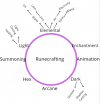Hexes are spells cast on people. They can be negative or positive. Permanent hexes require runes to be carved on bone. They will appear as a mark on your skin and constantly drain your magic. They can be broken by destroying the runes carved into your bone, but most people will add a spell of protection into their permanent hexes that prevents the hex from being cut/broken (the body can still be injured). Putting multiple permanent hexes on a person can cause them to interfere and corrupt each other.
Temporary hexes can be used to buff or weaken someone in battle. They are placed on the skin and have a time limit. Like permanent hexes, the hex is destroyed if the runes are destroyed. If the runes in a hex are simply damaged but not completely destroyed, this can corrupt the hex. In most cases a corrupted hex will simply stop working. For permanent and especially powerful hexes, the hex may change to have different, unintended, and often dangerous effects.
Enchantments and Hexes require the most intensive magical calculations. Enchanters and Hexers both study their base runes extensively. Luckily, these two classes of magic do not tend to stray outside of their base runes.
During the rock test, a rune (different from enchantment) will appear on the rock.
- Low mana costs
- Near instant cast speed (but must make contact with sufficient amount of skin, and often requires calculation)
- Uncommon ~13%
- 230 base runes
Note: stats are just a general guideline and vary by spell





